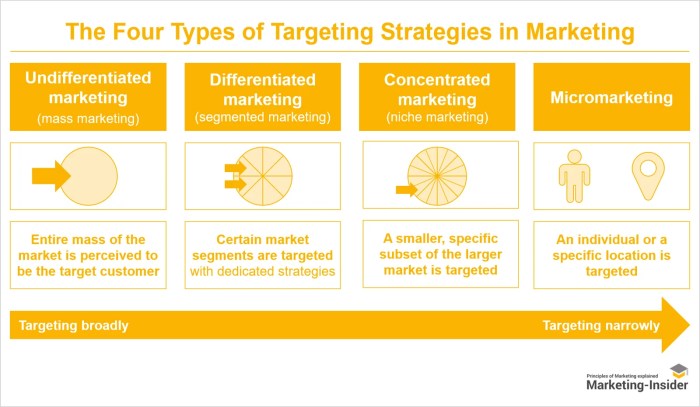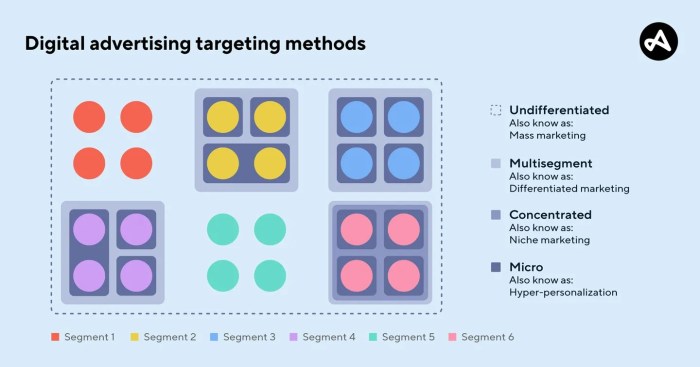
In the realm of marketing, the power of targeted advertising campaign strategies reigns supreme, guiding brands towards success through precision and relevance. This comprehensive guide delves into the core elements of crafting impactful campaigns that resonate with the right audience, setting the stage for a journey filled with insights and innovation.
From understanding the essence of targeted advertising to exploring the nuances of data-driven techniques, this narrative unfolds a compelling narrative that illuminates the path to advertising excellence.
Targeted Advertising Campaign Strategies
Targeted advertising plays a crucial role in the success of a campaign by allowing businesses to reach specific audiences with relevant messaging. By focusing on individuals who are more likely to be interested in their products or services, companies can increase the effectiveness of their marketing efforts.
Importance of Targeted Advertising
- Targeted advertising helps businesses maximize their return on investment by reaching the right audience.
- It allows for personalized messaging that resonates with potential customers, increasing the likelihood of conversion.
- By targeting specific demographics or interests, companies can reduce wasted ad spend on irrelevant audiences.
Effective Targeting Parameters for Online Advertising
- Geographic targeting: Tailoring ads to specific locations or regions based on customer location data.
- Behavioral targeting: Utilizing user behavior data to target individuals with relevant ads based on their online activities.
- Interest targeting: Targeting users based on their hobbies, preferences, or interests to increase engagement.
Impact of Demographic Targeting
Demographic targeting allows businesses to focus their advertising efforts on specific age groups, genders, income levels, and other demographic factors. By honing in on these parameters, companies can tailor their messaging to resonate with the target audience, leading to higher conversion rates and improved campaign performance.
Role of Personalized Content in Targeted Advertising Strategies
- Personalized content helps create a connection with consumers by addressing their individual needs and preferences.
- By delivering tailored messages, businesses can increase engagement and foster brand loyalty among customers.
- Personalization can lead to higher click-through rates and conversion rates, ultimately driving the success of an advertising campaign.
Effective Use of Social Media in Advertising Campaigns
Social media platforms have become essential tools for targeted advertising due to their vast user base and detailed targeting options. With the ability to reach specific demographics, interests, and behaviors, businesses can optimize their ad campaigns for maximum effectiveness.
Utilizing Social Media Analytics for Refining Targeting Strategies
Social media analytics provide valuable insights into the performance of advertising campaigns, allowing businesses to track key metrics such as engagement, reach, and conversions. By analyzing this data, marketers can identify trends, optimize targeting parameters, and refine their strategies for better results.
- Monitor Key Performance Indicators (KPIs) to track the success of ad campaigns.
- Identify high-performing audience segments and adjust targeting parameters accordingly.
- Utilize A/B testing to compare different ad creatives, copy, or targeting options.
- Continuously optimize ad campaigns based on analytics data to improve ROI.
Benefits of Influencer Partnerships in Targeted Advertising Campaigns
Collaborating with influencers on social media can significantly enhance the reach and effectiveness of targeted advertising campaigns. Influencers have a loyal following and can help businesses connect with their target audience in a more authentic and engaging way.
- Reach a larger audience through the influencer’s follower base.
- Build credibility and trust with the target audience through influencer endorsements.
- Create engaging and shareable content that resonates with the target demographic.
- Benefit from the influencer’s expertise in content creation and community engagement.
Examples of Successful Advertising Campaigns on Popular Social Media Platforms
Several brands have executed highly successful advertising campaigns on popular social media platforms, demonstrating the power of targeted advertising when leveraged effectively.
- Instagram: Fashion brand Revolve used influencer partnerships to showcase their clothing line, resulting in increased brand awareness and sales.
- Facebook: Airbnb utilized advanced targeting options to reach travelers based on their interests and behaviors, leading to a surge in bookings.
- Twitter: Wendy’s engaged with followers through witty and relatable tweets, creating a strong brand presence and driving customer engagement.
- LinkedIn: HubSpot shared educational content targeting B2B professionals, establishing thought leadership and generating leads for their marketing platform.
Data-Driven Targeting Techniques

Data-driven targeting techniques play a crucial role in the success of advertising campaigns by allowing businesses to reach the right audience with the right message at the right time. By leveraging data analytics, advertisers can identify their target audiences more effectively and tailor their ads to meet the specific needs and preferences of these audiences.
Use of Data Analytics in Identifying Target Audiences
Data analytics enables advertisers to gather valuable insights into consumer behavior, demographics, and preferences. By analyzing this data, advertisers can create detailed customer profiles and identify the characteristics of their target audience. This information helps advertisers to craft personalized and relevant ads that resonate with their target audience, leading to higher engagement and conversions.
- Utilize website analytics, social media insights, and customer relationship management (CRM) data to understand consumer behavior and preferences.
- Segment your target audience based on demographics, interests, and buying behavior to create targeted advertising campaigns.
- Use predictive analytics to anticipate consumer needs and deliver ads that are tailored to individual preferences.
Role of A/B Testing in Optimizing Targeted Advertising Campaigns
A/B testing, also known as split testing, allows advertisers to compare the performance of different ad variations to determine which one resonates best with their target audience. By testing different elements such as ad copy, imagery, and call-to-action buttons, advertisers can optimize their campaigns for maximum effectiveness and ROI.
- Run A/B tests on different ad creatives to identify the most compelling messaging and visuals.
- Test different targeting parameters to see which audience segments respond best to your ads.
- Optimize landing pages and conversion paths based on A/B test results to improve overall campaign performance.
Role of Retargeting in Improving Conversion Rates for Online Ads
Retargeting is a powerful technique that allows advertisers to reach out to users who have previously interacted with their ads or visited their website. By showing targeted ads to these users as they browse the web, advertisers can increase brand awareness, engagement, and conversions.
- Use retargeting to remind users about products or services they have previously viewed but not purchased.
- Segment retargeting audiences based on their behavior on your website to deliver personalized ad experiences.
- Optimize retargeting campaigns by analyzing performance data and adjusting targeting parameters for better results.
Using Data Insights to Create Personalized Ad Experiences
Data insights can be leveraged to create personalized ad experiences that resonate with individual consumers on a more personal level. By using data on past purchases, browsing behavior, and demographic information, advertisers can deliver ads that are tailored to each user’s preferences, increasing the likelihood of engagement and conversion.
- Customize ad creatives based on user preferences and past interactions with your brand.
- Personalize ad copy and offers to match the needs and interests of different audience segments.
- Implement dynamic creative optimization to automatically adjust ad content based on user data in real-time.
Advertising Services

Advertising agencies play a crucial role in designing targeted campaigns that effectively reach the desired audience and achieve the campaign objectives. These agencies have the expertise, resources, and experience to create compelling ad content, select the most suitable advertising channels, and optimize campaigns for maximum impact.
Benefits of Outsourcing Advertising Services
- Access to Expertise: Advertising agencies have a team of professionals with diverse skills and knowledge in marketing, design, and analytics, ensuring that your campaigns are well-executed and deliver results.
- Cost-Effectiveness: Outsourcing advertising services can be more cost-effective than hiring an in-house team, as agencies already have the necessary tools and resources to run campaigns efficiently.
- Time-Saving: By entrusting campaign management to advertising agencies, businesses can focus on their core operations and leave the advertising expertise to the professionals.
- Scalability: Advertising agencies can scale campaigns according to budget constraints and business goals, providing flexibility and adaptability to changing market conditions.
Types of Advertising Services
| Service | Description |
|---|---|
| Creative Services | Includes ad design, copywriting, and content creation for various advertising channels. |
| Media Planning & Buying | Involves selecting the right media platforms and negotiating ad placements for optimal reach and visibility. |
| Digital Marketing | Utilizes online channels such as social media, search engines, and email to promote products or services. |
| Public Relations | Focuses on managing the public image of a business through media relations, events, and communication strategies. |
Measuring the Effectiveness of Advertising Services
- Key Performance Indicators (KPIs): Tracking metrics such as click-through rates, conversion rates, and return on investment (ROI) to evaluate the success of advertising campaigns.
- A/B Testing: Conducting experiments to compare different ad variations and determine which ones perform best in terms of engagement and conversions.
- Customer Feedback: Gathering insights from customer surveys, reviews, and feedback to understand the impact of advertising on target audiences.
As we conclude this exploration of targeted advertising campaign strategies, one thing remains clear – the key to unlocking unparalleled success lies in the art of strategic targeting. By harnessing the potential of personalized content, social media integration, and data-driven insights, brands can amplify their reach and impact, paving the way for a future where advertising transcends boundaries and connects with audiences on a profound level.
Helpful Answers
How does targeted advertising differ from traditional advertising?
Targeted advertising focuses on reaching specific audiences based on various parameters, ensuring higher relevance and engagement compared to broader approaches in traditional advertising.
What role does personalized content play in targeted advertising strategies?
Personalized content enhances the effectiveness of targeted advertising by tailoring messages to individual preferences, increasing engagement and conversions.
Why is data analytics crucial in identifying target audiences for advertising?
Data analytics provides valuable insights into consumer behavior and preferences, enabling advertisers to create targeted campaigns that resonate with their desired audiences.





